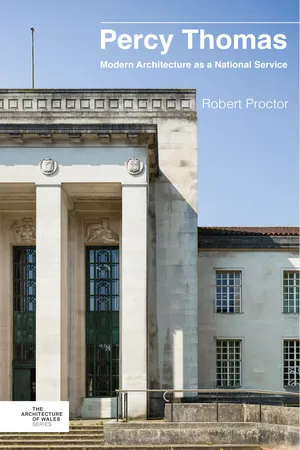
- 376 pages
- English
- ePUB (mobile friendly)
- Available on iOS & Android
About this book
Sir Percy Thomas was the most important twentieth-century architect in Wales, renowned for interwar civic buildings such as Swansea Guildhall and the Temple of Peace in Cardiff. His architectural practice, Sir Percy Thomas & Son, designed much of the post-1945 welfare state and industry in Wales and beyond. In the late twentieth century, the Percy Thomas Partnership specialised in complex healthcare, industrial and public buildings, becoming an international practice.
This comprehensive, meticulously-researched history examines the architecture of Percy Thomas in depth for the first time, and explores its wider social and political significance. Arguing that the practice sustained an ethical approach to architecture as a 'national service' for the benefit of society, this book gives new insights into the role of the architect and the changing relationships between the built environment and the state throughout the century. Its unique perspective from Wales promises to reshape our understanding of modern architecture.
Frequently asked questions
- Essential is ideal for learners and professionals who enjoy exploring a wide range of subjects. Access the Essential Library with 800,000+ trusted titles and best-sellers across business, personal growth, and the humanities. Includes unlimited reading time and Standard Read Aloud voice.
- Complete: Perfect for advanced learners and researchers needing full, unrestricted access. Unlock 1.4M+ books across hundreds of subjects, including academic and specialized titles. The Complete Plan also includes advanced features like Premium Read Aloud and Research Assistant.
Please note we cannot support devices running on iOS 13 and Android 7 or earlier. Learn more about using the app.
Information
Table of contents
- Cover
- Title
- Copyright
- Contents
- General Editor’s Preface
- Acknowledgements
- List of Illustrations
- Abbreviations
- 1 Introduction
- 2 Modern Classicism and Municipal Democracy
- 3 Commerce, Consumption and Community: The City and the Suburb
- 4 Industry and Infrastructure in the Welfare State
- 5 Place, Landscape and Heritage
- 6 Architecture and the Neoliberal State
- 7 Conclusion
- Select Bibliography
- Picture Section
- References